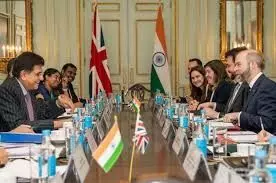India-UK Trade Pact Signals Strategic Shift Amid Global Realignments

The long-anticipated Free Trade Agreement (FTA) between India and the United Kingdom marks a critical juncture in the evolving dynamics of international trade, not merely for its economic significance but more so for its strategic undertones.
The negotiations, spanning multiple UK administrations and enduring multiple missed deadlines—including former UK Prime Minister Boris Johnson’s ambitious Diwali 2022 target—have now culminated in a framework that reflects the broader recalibration of global economic alignments in a post-pandemic, increasingly multipolar world.
At the core of this development lies a new political and economic pragmatism. Trade is no longer confined to tariff concessions and market access; it is deeply intertwined with geopolitical strategy. The United States’ tariff offensive on China under the Trump administration—policies largely maintained and even expanded by subsequent governments—has acted as a catalyst in redefining trade priorities across major economies. In this context, India’s agreement with the UK serves not only as a bilateral milestone but also as a template for future negotiations, particularly with the European Union. It positions India as a counterweight to China in the global value chain, a proposition increasingly embraced by Western economies seeking to diversify away from overdependence on a single supplier nation.
What stands out is the enhanced role of India’s Ministry of External Affairs and the Prime Minister’s Office in trade discussions—a departure from the traditional dominance of the Ministry of Commerce. This reflects a broader understanding that trade pacts are no longer just about economics; they are also about diplomacy, security, and long-term strategic interests. For India, this means leveraging its demographic advantage, expanding manufacturing base, and relatively stable political environment to attract multinational investments. The UK, reeling from the post-Brexit trade vacuum, views India as both a commercial opportunity and a geopolitical ally in the Indo-Pacific, where the contest for influence against China is intensifying.
The FTA comes against a backdrop of sweeping tariff barriers, particularly from the United States, that are reshaping global supply chains. While initially viewed as protectionist, these tariffs have inadvertently spurred a diversification push among global manufacturers, who are now seeking alternatives to China’s once-dominant manufacturing ecosystem. India, with its large domestic market, skilled workforce, and improving infrastructure, is emerging as a key beneficiary of this shift. The India-UK trade pact is timely in this regard. It sends a strong signal that New Delhi is open for business and willing to engage in comprehensive economic partnerships—provided these are aligned with its strategic imperatives.
The deal is also expected to serve as a springboard for India’s long-delayed FTA with the European Union, which has historically been mired in disagreements over issues like intellectual property rights, data privacy, and labour standards. With the UK agreement as a reference point, New Delhi now holds a stronger negotiating hand. If successful, an EU-India FTA would have far-reaching implications, given the bloc's economic clout and its interest in forging closer ties with Indo-Pacific democracies. The potential gains are considerable: greater market access for Indian textiles, pharmaceuticals, and machinery; increased technology transfer; and deeper integration with Western supply chains.
For the UK, the agreement offers a rare post-Brexit trade win. Struggling to cement new economic partnerships outside the EU, London has found in India a partner that offers both scale and strategic relevance. The pact could help reinvigorate British exports, particularly in financial services, education, and high-end manufacturing, while also fostering innovation collaborations in sectors such as fintech, green energy, and artificial intelligence.
However, challenges remain. The asymmetry between the two economies, especially in regulatory standards and development levels, could create friction during implementation. Domestic resistance in India, particularly from politically sensitive sectors like dairy and agriculture, may demand continued calibration of the pact. Similarly, labour mobility—a key demand from India—may run into political resistance in the UK, where immigration remains a contentious issue.
Nonetheless, the broader trajectory is clear: trade agreements are no longer mere instruments of economic liberalization; they are components of a wider strategic toolkit. By concluding a deal with the UK, India is signalling its readiness to play a larger role in shaping the post-globalization order. This strategic signaling is not lost on investors. As global supply chains undergo a tectonic realignment in response to US tariffs and broader geopolitical tensions, India’s trade diplomacy could unlock new avenues of foreign direct investment and technological partnerships.
The India-UK FTA is thus more than a bilateral accord—it is a statement of intent. It reflects a convergence of interests shaped by shifting geopolitical realities and the need for economic resilience. It reinforces India's image as a credible, reform-oriented economy that is willing to engage the world on its own terms. At a time when the global trade environment is increasingly defined by fragmentation and uncertainty, such clarity of purpose is not only rare—it is necessary.
